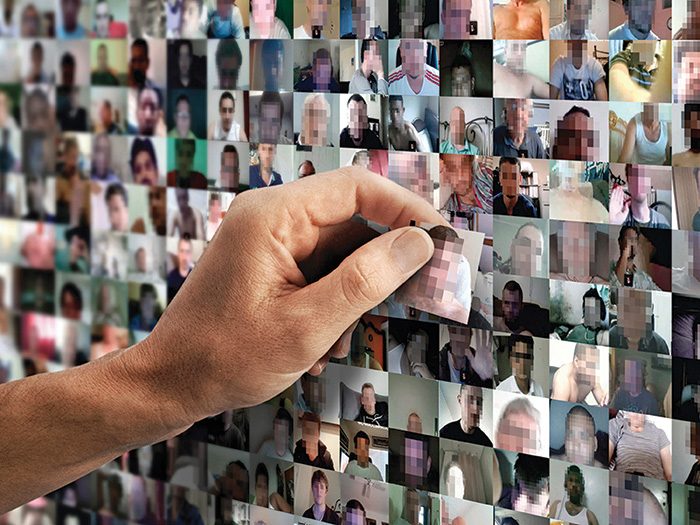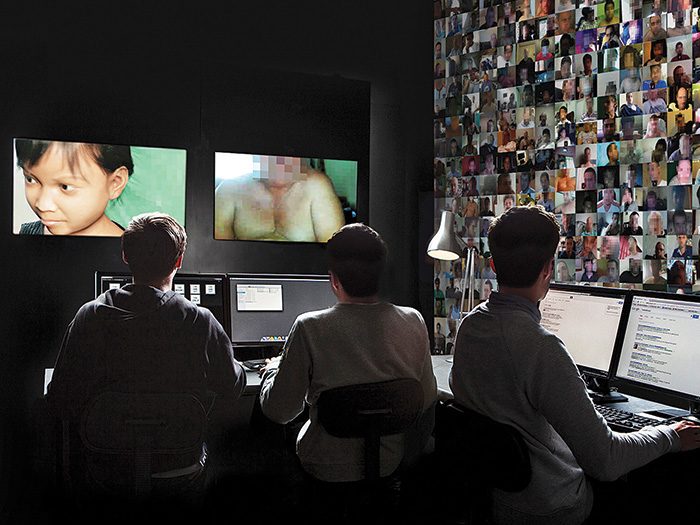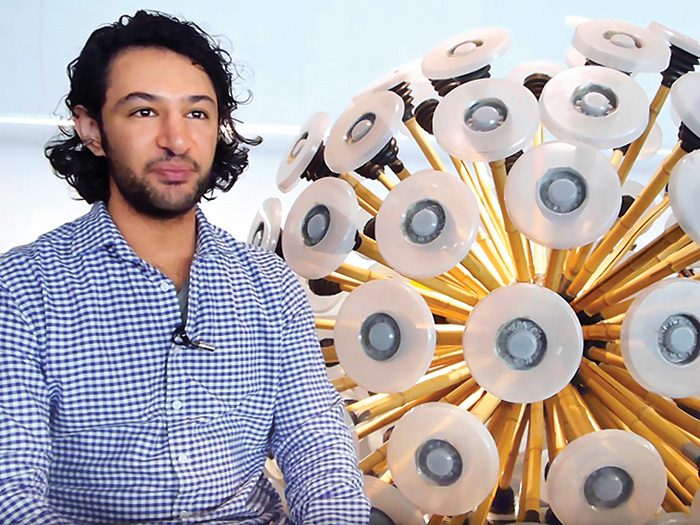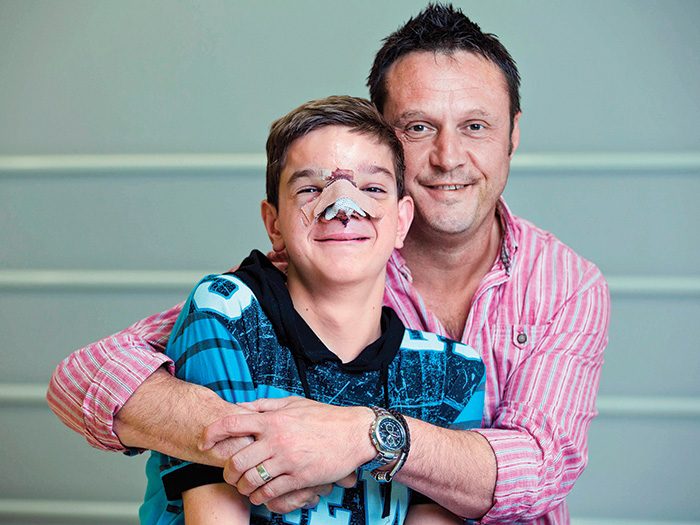
15 Minutes with Gerry Dee
Reader’s Digest: Mr. D is up for a handful of trophies at the Canadian Screen Awards this year. How do you feel about awards?
Gerry Dee: I don’t put a lot of stock in winning or losing. I think winning in this business is staying on television. To me, that’s your biggest award. It’s always an honour to be nominated and it’s even more exciting to win, but these things are tough to win.
You’ve written and directed a number of episodes. How do you approach a new season of television?
Any show that’s in its sixth or seventh season faces the challenge of continuing to come up with new stories. Fortunately we have a great group of writers and directors to really steer the ship in the direction we want to go. We challenge ourselves, and I think every season we’ve done is better than the last.
Sports are important to you and to the show. Who’s an athlete you’d love to meet that you haven’t already?
I’d love to meet Jack Nicklaus because I’m such a big fan of golf. Tom Brady would be fun too, him being at the height of his career and all. Those two athletes stand out for me.
You’re about to go on another stand-up tour. Have you gotten used to travelling?
The travel part is never glamorous—I have three young kids and I miss a lot of their things when I’m travelling. It’s all about getting up on stage. Once you get to town, then you can spend some time in these great places and ultimately get on that stage. That’s the part to look forward to. That’s why I got into stand-up.
When writing jokes, are you worried about being politically correct or inoffensive?
I generally stick to what’s going on in my life—my wife, my three kids, my past teaching career and the school system. But there are times when I struggled with some topics. It’s very easy to get up on stage and say whatever you want, but you have to realize that there are repercussions. There are people in the audience that are dealing with situations. I try to be aware of that, but I can’t censor my comedy to the point where I’m not talking about what I think is funny.
If you were ever forced to go back into teaching, would you be different?
I was pretty strict actually, which a lot of people are surprised by, so I’d probably be less strict. I’d also try to enjoy the little moments a bit more, but I wouldn’t deviate too much. My style was my style, though I’d maybe want to get into the administration side of things, like being a principal or vice-principal. But then again, that’s never going to happen.
Tickets to Gerry Dee’s 2017 stand-up tour are available now.

15 Minutes With Graham Greene
Reader’s Digest Canada: You play God in your new movie, The Shack. How do you get ready for a role like that?
Graham Greene: Well, I never really prepare. That particular day, after I got made up, I looked into the mirror and based the character on an elder who was one of my teachers before he passed away. His gentleness was incredible.
The Shack is a faith-based film. Did that affect your decision to sign on?
I’m not a churchgoer; my beliefs are personal. I’m a working actor with a mortgage to pay. If I don’t work, I get edgy and miserable. To make themselves interesting, a lot of performers come up with horse-poop ideas about why they took certain parts. The role looked intriguing; it was offered to me and I accepted.
Many people know you from your Oscar-nominated performance in Dances With Wolves. More than 25 years later, what do you remember most about that experience?
My horse. He and I got on like a house on fire. On the last day I was shooting, this kid came up and told me it had been his—turns out he’d had to sell it. After filming, I went to the producers and said, “Make sure this kid gets his horse back. Take it out of my salary if you have to.”
You also starred opposite wolves in Twilight. You clearly don’t subscribe to that adage about how a smart actor never works with animals or children.
I also did a TV series called Wolf Lake with Lou Diamond Phillips.
Any advice on dealing with vulpine co-stars?
Don’t. The ones in Dances With Wolves were pretty unpredictable. They were supposedly trained, but you never really knew what they were going to do. They were wild animals.
You recently appeared in Te Ata, a biopic about a Native American entertainer in the early 20th century. Is it important to you to tell the stories of First Nations people?
Not particularly. I’ve played old Jewish men, New York police officers, French soldiers. I’m a fan of diverse casting. I hate that phrase, “Graham Greene, Native actor.” You don’t hear people say, “Denzel Washington, black actor,” or “Kevin Costner, white actor.”
Maybe it’s a reflection of the fact that there aren’t enough working First Nations actors.
I don’t know about that. There are a lot more Native actors out there than there were 40 years ago, when I started. When kids ask for advice, I say learn how to wait tables, get your cab licence and develop a thick skin.
You’ve said you never intended to be an actor. What would you be doing now if you hadn’t chosen this route?
I’d probably be a welder. I started out as a carpenter, a welder, a draftsman, a carpet layer, a roadie and an audio tech. I stumbled into acting and I thought, These people keep me in the shade, give me food and water, take me over to where I say what I’m supposed to say, then they take me back. Wow—this is the life of a dog!
The Shack is in theatres March 3.

An insomniac friend unwittingly hijacked my sleep recently. I’d never had trouble staying asleep before, but my friend started texting at 2 a.m. to pass the time. I keep my mobile phone on my nightstand, so his texts disturbed me, even with the phone on vibrate—the buzz, accompanied by a lit screen, jolted me awake. Eventually, I activated a do-not-disturb setting: My phone remained blissfully silent and dark when I received unwanted texts between 11 p.m. and 8 a.m., and my sleep returned to normal.
Mobile phone alerts, bathroom trips or other causes spoil many people’s nightly rest. International guidelines suggest that adults should sleep between seven and nine hours nightly, but a survey of six countries,* including Germany and the United Kingdom, shows that about 40 percent of us don’t get enough rest.
Chronic sleep deprivation isn’t just making us groggy; it can harm our health: Research shows that adults who don’t sleep enough are more likely to be sedentary and obese, and they’re at greater risk of diabetes, heart disease, depression and common illnesses like colds.
“Sleep is so important to physical and mental health,” says Neil Stanley, a sleep researcher in Farnborough, England. “Anything that causes poor sleep on an every-night basis can have associations with risk factors for diabetes, obesity, depression and other problems. You have to look at things that you potentially can do to improve the situation.”
Fortunately, you don’t have to swear off coffee, rely on sleeping pills or buy a fancy mattress to get a good night’s rest. These offbeat tips may help improve the quality of your slumber:
Ditch your smartphone
Studies show that up to 60 percent of adults keep their mobile phones in the bedroom at night. You’re more likely to stay up too late texting, e-mailing or using social media, then feel drowsy the next day.
“We know from research that using one app leads to another, so you are likely to spend more time on your mobile phone than you have intended to,” says Liese Exelmans, a researcher at the School for Mass Communication Research at the University of Leuven, Belgium. “People over 60 who use their mobile phones at night have a shorter sleep duration.” Older people are more likely to be morning persons, with a biological tendency to wake up earlier, or they may need to rise early for work or other activities.
Sleep experts recommend against bringing phones into the bedroom, but this is unrealistic for adults who use their phones as alarm clocks and who want to feel connected to friends through their devices. “Many people have a feeling that they are disconnected from the real world if their phone is not in the bedroom,” Exelmans says. “It triggers hypervigilance. You are not completely at rest, because you expect to be contacted sometime during the night. It’s the fear of missing out.”
Donny Soh, 38, of Singapore, experienced this phenomenon first-hand. When his company launched a new product last year, he’d wake up at all hours to see if anyone had placed online orders. “I would wake up perhaps three to four times per night,” says Soh, who admits that an attitude change helped him reclaim his slumber. “Regardless of how awake I am or how often I check my phone, it doesn’t really affect the sales, and since this realization, sleep got much better.”
The blue light that smartphones emit can also negatively impact sleep. Blue light mimics daylight, so the body is discouraged from producing sleep-inducing melatonin at bedtime, which promotes drowsiness. “The blue light emitted by mobile phones inhibits melatonin output, telling your body to stay awake,” Exelmans says. Adding an app with a blue-light filter can help.

If you’re unwilling to part with your mobile phone overnight, minimize interruptions and encourage sleep by activating nighttime blackout periods, so that no calls, texts, e-mails or notifications go through.
“Keep it on flight mode, dim your screen and place it on silent mode,” Exelmans says. “Or remove some apps: Facebook, work e-mail—it discourages you from spending time on it.”
Computers and televisions emit the same blue light that smartphones do. Best to keep computers and TVs out of the bedroom, and turn them off one to two hours before bedtime. And if you wake up in the middle of the night, refrain from turning to a screen. Says Exelmans, “Read a book, not a tablet.”
Put your feet up
Is your nighttime slumber interrupted by urgent bathroom visits? You may have a little-known condition called nocturia, which awakens people from a sound sleep two or more times per night with the strong urge to urinate. As many as three out of five older adults suffer from nocturia, which negatively impacts sleep.
“Even in people who fell asleep easily again,” says Dr. Philip E.V. Van Kerrebroeck, professor of urology at Maastricht University in the Netherlands, “the interruption of sleep disrupts the normal sleep patterns and can have general health consequences: high blood pressure, diabetes. And it can have an impact on the cognitive function.”
Nocturia isn’t a disease; rather, it’s a symptom of conditions like sleep apnea, male prostate problems and lower estrogen levels in women. Many people assume that it’s a normal part of aging.
“With aging, there are problems that install themselves, but the night is to sleep and not to pee,” Van Kerrebroeck says. “Sleep is a protective mechanism. An elderly individual has the right to a healthy life.”
Lifestyle changes may help: Drinking no more than two liters of liquid daily, curtailing in the evenings; avoiding caffeine and alcohol for six hours before bedtime; taking diuretics in the morning or early afternoon, rather than later in the day; and elevating your legs.
When you put your feet up before bedtime, it pushes the fluids that have accumulated around your ankles back into the bloodstream, allowing you to urinate out the excess fluid while you’re awake. If you don’t elevate your legs until you slip into bed, the excess fluid becomes urine while you sleep, leading to nighttime awakenings. How long you’ll need to sit with your feet up depends upon your personal health.
“With varicose veins or edema, it may take longer for the fluids to return,” Van Kerrebroeck says. “There’s no problem to do it for two hours. For many people, half an hour might be too limited.”
Many people can improve nocturia with lifestyle changes, but for those who cannot, research has shown that the drug desmopressin can cut the number of nightly bathroom visits in half for 30-40 percent of older adults, significantly improving sleep quality.

Do the Downward Dog
A recent study from the University of Washington found that older women who took yoga for two months reported considerably less insomnia. The gentle motions and poses may help reduce stress levels and improve blood flow, which makes it easier to sleep.
“Look for the kind of yoga in which the breath is really involved,” says Versailles-based yoga teacher Laurence Maman, a member of the teachers’ trainers’ college of the Institut Francais de Yoga, affiliated with the European Union of Yoga. “By using exhalations rather than inhalations, you can influence the relaxation effect.”
The relaxation response or effect has been shown to lower blood-pressure levels, reduce stress and encourage sleepiness. Maman recommends practicing yoga for 15 or 20 minutes before bedtime, choosing a lying-down position that emphasizes relaxed breathing. “It can rather quickly have an effect on sleep quality.”
When New Jersey resident Jodi O’Donnell-Ames turned 50 this year, she started awakening at 3 a.m. nightly, unable to fall back asleep. The longtime yoga practitioner turned to yoga for help.
“I used to practice power yoga more for cardio than for relaxation,” O’Donnell-Ames says. “I added gentle yoga flow to my weekly routine. It took two weeks to see a consistent difference.”
Grab dinner with friends
Whether you have an emotionally fulfilling day may influence the soundness of your sleep. Researchers at the University of Chicago found that many people who are unable to sleep through the night feel isolated from family and friends. These lonely people take longer to fall asleep at bedtime, and they’re more likely to toss and turn in the middle of the night, sleep for fewer hours and experience daytime grogginess more often than emotionally connected people.
Older adults are particularly susceptible to emotional loneliness. “Later life contains events such as retirement, children leaving home, and potentially bereavement and widowhood,” says psychologist and researcher Joanna McHugh of Trinity College Dublin. “All of these events may create loneliness.”
Interacting with people meaningfully during the day may help to improve sleep quality, although there are no cookie-cutter guidelines. “The link between loneliness and sleep quality is still relatively new and under-researched, so it is hard to make recommendations,” McHugh says.
Seeing friends may make you feel more emotionally connected, but you may not be able to socialize as often as you’d like. Some research suggests that chatting with friends by phone may provide ample emotional support, but texting and social media won’t cut it. Counseling may be necessary for some. “One can feel lonely despite being highly socially connected,” McHugh says. “It cannot be resolved purely by social contact.”
Try another bed
Falling asleep next to a snoring partner can be frustrating and tiring. Research shows that half of nighttime sleep disturbances are caused by disruptive bedmates. This can translate to chronic sleep deprivation, depression, heart disease and relationship problems. “People who have poor sleep actually have a higher rate of divorce,” Stanley says. “The next day, you’ll have more arguments, be less likely to make up and have a lack of empathy toward that person. It’s a potential recipe toward marital disharmony.”
A simple fix: Sleep in separate bedrooms. Researchers have confirmed that people get better-quality rest alone, which can positively impact your health and your relationship. “Sleep is the most selfish thing that you can do,” Stanley says. “If you’re sleeping alone, you’re not going to have somebody snoring, kicking, getting up to go to the bathroom or just turning over.”
About one-third of married couples sleep in separate rooms, according to Toronto researchers. This trend has been slowly gaining momentum for a decade. “Talking about sleeping separately is probably one of the biggest taboos,” Stanley says. “Other people say if you’re in a relationship, you must share a bed or you’re calling into question your relationship. That’s complete and utter nonsense.”
Want to try separate rooms? Broach the subject in a loving, non-judgmental way when it isn’t bedtime.
“It really is about saying that sleeping separately isn’t a withdrawal of the self, that you’ll kiss and cuddle and when you say goodnight, rather than turning to the other side of the bed, you’ll go to the other room,” Stanley says. “People get sent to the back room or the couch as if it’s a punishment. But you say, ‘I want a good night’s sleep, so I’m going to sleep in the back room, but it’s going to be my room. It’s not going to be a punishment.’ If you do it in a loving way and you remain intimate, it works.”
Watch what you ingest
What you eat and drink in the evening can affect your sleep quality. A heavy meal right before bedtime can cause stomach acid to rise into your esophagus, which we know as heartburn, especially if you consume spicy foods, tomato-based products or chocolate. The burning, painful symptoms of heartburn may keep you from falling asleep or may wake you.
Chronic heartburn may be a sign of gastroesophegeal reflux disease (GERD), which can cause serious problems over time. Lying down after eating may exacerbate GERD. Says gastroenterologist Dr. Gary Falk, a professor of medicine at the Hospital of the University of Pennsylvania. “With lying down and going to sleep, one loses the defenses of gravity, saliva and swallowing.”
To minimize reflux, stop eating two to three hours before bedtime. To keep gravity working in your favor, elevate the head of your bed, says Dr. Joseph Ojile, medical director of the Missouri-based Clayton Sleep Institute.
Alcohol can also cause reflux, but there are other reasons to avoid drinking late in the evening. Alcohol is a diuretic, which means that you’ll have to pee soon after imbibing. And some drinks are worse than others. “Beer has an effect of stimulating the urine production,” Van Kerrebroeck says.

Chill out
People sleep best when the bedroom is about 65 degrees Fahrenheit (18 degrees Celsius), according to research. Your temperature naturally drops as bedtime approaches, so keeping your bedroom cool helps your body adjust itself more efficiently.
“Warmth is a signal to the brain to stay awake for many people, says Ojile. “Throughout the night when it’s hot, you have this constant stimulation, which is wake-promoting. And there’s a tactile issue, too—some people have trouble sleeping if there are no sheets or comforters on them.”
Try keeping your thermostat at a cool temperature year-round. If your partner likes it warmer than you do, consider products that can keep you cooler than your bedmate, such as a gel pillow cover or a temperature-controlled heating-cooling pad that fits over only your half of the bed.

Friday, July 5, 2013
Burpengary, Queensland, Australia
It was at 2:16pm on a warm July evening that Scott Robert Hansen first met Sweetie.
Sitting alone in front of a computer screen in his home not far from Brisbane, the single 36-year-old logged into a chat room and typed in the username “2 cam with kid.” Then he clicked “Kids Chat.”
That’s when her username appeared: “9 f philippines.”
Hansen knew that in the shady online networks he frequented, those letters could signify only one thing: a nine-year-old girl from the Philippines. Heart pounding, he typed: “Wanna chat or cam with older? I like asian chicks, u horny for action…i’m naked, ever seen a guy naked?”
After a few seconds a single word popped up: “Yes.” The conversation quickly moved to Skype at the girl’s request. Hansen called her from his personal account, where his name, photograph and location were listed.
“I with me sister she is 8,” typed the Filipino girl. “If you likes we does 20 minutes sexy show for $2.”
“OK, please video call me, I can do that,” wrote an excited Hansen.
Had the girl turned on her video cam, Hansen would have seen what he was expecting: a thin, brown-skinned, pre-pubescent child sitting at a keyboard. The girl would nod complacently, adjusting her webcam and typing out responses while, thousands of miles away, Hansen negotiated her purchase for a few dollars an hour.
But Hansen would never see the girl, for there was no need for her to appear: he had already been caught.
Two years earlier
Cebu, Philippines
Hans Guijt was baffled. As the director of projects for the Dutch arm of the children’s welfare organization Terre des Hommes, he’d been visiting the Philippines for years, working to solve its rampant child prostitution problem. Terre des Hommes had been fighting to protect vulnerable children for decades through its branches across Europe and Canada. Hans had been with the organization since 1999, taking the lead on ambitious projects around the world. Before that, the feisty 58-year-old was Greenpeace’s campaign director. He had a track record for getting things done.
But as he wandered the streets of Cebu’s slums, Hans marvelled at how the kids who had once sold their bodies here had all but disappeared.
Something else had changed, too. On nearly every corner, what had once been a shack was now an “internet cafe,” These rudimentary iron-roofed huts housed rows of cheap computers that connected to the web for a few cents a minute.
Hans noticed that kids were sitting in front of these screens. Through conversations with children at drop-in centres and shelters, he discovered a vast new phenomenon sweeping impoverished Filipino communities: webcam child sex tourism.
Easy access to the Internet was allowing individuals anywhere to purchase live webcam sex shows from a growing number of Filipino children. A fee would be negotiated and then paid via Western Union. A pimp or someone else over 18 went to collect the money, and the show would begin. Usually one or two girls would hold a towel as a makeshift screen in front of which another would take off her clothes and “perform” for the camera.
While some children made contact on their own, others were sold by pimps through so-called “cyber sex dens” and still others were offered up for sale by their own parents.
Hans consulted with the team back in The Hague and then ordered an intensive six-month investigation of the phenomenon. He was horrified by its findings. Tens of thousands of children in the Philippines were suffering online abuse, found to be just as mentally damaging as physical sexual abuse.
Police were doing little to curb the abuse. Only six men had ever been sentenced for the crime—and an estimated 750,000 individuals were online at any given moment looking to prey on children.
Determined to get the word out, Hans invited two Dutch journalists to the Philippines to witness what was happening. One, a seasoned reporter named Elsbeth Stoker, wrote a feature for the Dutch daily newspaper de Volkskrant. It was published on May 29, 2012 under the headline, “All the men were naked and playing with themselves.”
That same May morning Mark Woerde was enjoying his coffee and flipping through the newspaper when the article by Stoker caught his attention. As the co-founder and strategy director of the Amsterdam-based advertising agency Lemz, Mark believed that advertising experts like himself should be a force for good. He was always on the lookout for new projects. As he read the article, his mind was flooded with ideas. He looked up the number for Terre des Hommes and picked up the phone.
Six months later, three men sat close together in the boardroom at Terre des Hommes headquarters in The Hague. Joining Mark Woerde and Hans Guijt was Albert-Jaap van Santbrink, CEO of Terre des Hommes.
Now Mark presented his perspective: the problem of online child sex tourism was one of supply and demand, and it was clear that the demand side needed to be addressed. He had a plan: they would create a virtual girl and use her to infiltrate chat rooms and catch predators in the crime of soliciting sexual performance. Once she had caught enough to illustrate the scope of the problem, they would reveal their findings to the public.
At first Albert-Jaap was apprehensive. It was a complicated project for Terre des Hommes and one with potential legal implications. But Mark and Hans were adamant that the approach would work. With Albert-Jaap convinced, Hans was made team leader.
At the end of the meeting, they gave the girl a name: Sweetie.
From its beginning in spring 2013 “Project Sweetie” was a group effort. Terre des Hommes would spent an estimated 450,000 euros on it from start to finish. Other contributors would fund some two-thirds of the campaign through donated time and services.
Mark, Hans and Albert-Jaap agreed that “Project Sweetie” would be top secret until it was completed. They didn’t want online predators savvy to their sting. Nor did they want lawyers accusing them of entrapment or policemen insisting police work be left to them.
Mark brought three trusted associates from Lemz into the loop, and they quietly reached out to Motek Entertainment, a cutting-edge agency specializing in 3D modelling and animation. Motek’s lead animator Oshri Even-Zohar was eager to join the project, and the creation of Sweetie began.
First, Oshri and three other Motek artists created a repository of references from hundreds of images of Filipino girls. Using these, they designed Sweetie’s facial features—everything from the bones in her cheeks to the thickness of her skin.

Next, the team designed Sweetie in two dimensions, painting and drawing her with different expressions and from various angles. What did Sweetie look like when sad? Happy? Embarrassed? The team created a vast mood board and then modelled it in 3D.
Finally, it was time to use motion capture to animate Sweetie. An actress specialising in mime acted out the 25 movements Sweetie would be able to perform, from nodding yes, shaking her head no, smiling, adjusting her web cam and typing, to getting up and exiting the frame. Each was synced with a keyboard command so that Sweetie’s responses could be easily controlled in real time.
The entire process took close to six months
Then Oshri proudly presented the petite brown-skinned girl to Mark, Hans, Albert-Jaap and the rest of the small team. Sweetie had to be convincing. He walked her through her range of movements, then turned to face his audience. Every single member was smiling.
Sweetie was a go.
It was July 2013 and the team had rented an empty warehouse space in the desolate industrial harbour of Amsterdam. They boarded up the windows. When the landlord asked questions, Mark said they were shooting the new IKEA catalogue and couldn’t have any leaks.
Then they loaded in laptops, screens, routers, online security gear and webcams. All the computers but one had been programmed with IP addresses that appeared to be in the Philippines. The remaining laptop was “air gapped,” never having been connected to the Internet and was therefore safe from hacking. This was where data on the identities of the predators would be stored.
Then the infiltration began. Four operators specially scouted by Mark entered chat rooms that Hans knew were playgrounds for predators. The operators worked in pairs. While one engaged the predator with Sweetie, the other used clues from the chat to search the web and identify the individual.
Hans watched as Sweetie entered her first chat room. No sooner had she posted her username than requests to make contact flooded in. Men from all corners of the globe were eager to share personal information—emails, Skype addresses, real names, naked photographs—in the hopes of purchasing webcam sex with a pre-pubescent girl. Sometimes they demanded a glimpse of Sweetie before revealing their identity. When they did, she would appear, her movements guided by the keystrokes of her operators.
Hans was shocked by the obscene requests these men were making. Bestiality. Rape scenes. Violence. Amplifying the horror was the fact that Hans was a father himself. His twin boys were almost the same age as Sweetie.
The operation continued for ten weeks. Sweetie entered just 19 of the 40,000 chat rooms the FBI estimates are populated by predators. Yet she interacted with no fewer than 21,172 men.
On the air-gapped laptop was a list of the real identities of more than 1,000 predators from 71 countries around the world. Scott Robert Hansen’s name and location there.
On November 4, 2014, at Terre des Hommes headquarters, Albert-Jaap looked out over the crowd of reporters and television cameras that surrounded the podium where he stood. Adjusting the microphone, he broke a story that would in a matter of days be a global news phenomenon.
“This is the largest sexual abuse case in history,” said Albert-Jaap. He explained how Terre des Hommes researchers had identified so many child predators. “Video footage of those predators has been handed over to the police authorities today.”
The Dutch police duly passed on the files to Europol. Those concerning individuals outside Europe went to Interpol, which distributed them to police in the relevant countries. Scott Robert Hansen’s file finally landed on the desks of the Australian Federal Police.
Tuesday, February 3, 2014
Queensland, Australia
Hansen looked on helplessly as federal officers clicked through the files on his home computer, knowing what they would find: 11 hours of the most depraved child sexual exploitation films, along with 79 images of child pornography. By the end of the day he would be in police custody.
On Tuesday, October 21, 2014, Judge Julie Ryrie looked down at Hansen from her bench in Brisbane District Court. The records showed that he was no first time offender. He’d flashed young kids on numerous occasions and even attempted to snatch a child on her way home from school—crimes for which he had done prison time.
Now Hansen was facing charges not just for possession of child exploitation material and breach of recogninisance but for “using a carriage service to transmit indecent communication to a person under 16 years of age.”
Hansen had used the internet to Skype indecent videos of himself to Sweetie. Yet this “person” was not a child at all, but rather a team of men posing as a little girl. Hansen had already pled guilty on all three counts. Now how would the judge sentence Hansen, with the knowledge that Sweetie was in fact not a real girl at all.
In her closing comments, public prosecutor Laura-Leigh Manville didn’t mince words describing the obscene acts Hansen had performed before the camera and Sweetie, all the while believing Sweetie to be a young Filipina. She asked that the judge treat this case as if Sweetie were a real person.
In sentencing, Judge Ryrie said Hansen had “a protracted interest in targeting children in various ways,” The fact the girl was not real was irrelevant, she said: “If you believe that’s a nine-year-old girl, then that’s the law, that’s good enough.” She sentenced Hansen to 12 months in prison.
It was Sweetie’s first conviction.
Since Hansen’s sentencing, men in Belgium, Denmark, UK , the Netherlands, Poland and the US have been arrested for their interactions with Sweetie and at least nine have beenconvicted. There are probably more convictions but exact numbers are difficult to track as no one is obliged to report them to Terre des Hommes.
Sweetie’s work has just begun. She has now been turned into an automated chatbot, called Sweetie 2.0, that can have convincing online conversations without an operator. Testing of the new version started in September. This phase will come to an end in April. Information on the worst repeat perpetrators encountered during the test run will be passed onto Europol and Interpol, and the software will be offered to law enforcement agencies around the world.
“One in four individuals who start with watching child pornography will then move on to hands-on child sexual abuse. Early intervention with Sweetie 2.0 could stop that,” says Hans.
With the collaboration of police forces internationally, Sweetie 2.0 has the potential to make predators like Hansen think twice before attempting to abuse children on the other side of the world.

Beating landmines
Technology Massoud Hassani is on a mission. He wants to rid the world of unexploded landmines, safely and quickly. Now an industrial designer, he spent his childhood in Afghanistan, which is plagued by up to 10 million of them. “Every destroyed landmine means a saved life and every life counts,”he says.
The 32-year-old came up with his first invention in his final year at college in the Netherlands, where he now lives. Inspired by the lightweight paper toys that he made as a child, he devised a giant ‘puffball’ made of bamboo rods with plastic feet (above). Light enough to be blown by the wind, but heavy enough to detonate a mine, the so-called ‘Mine Kafon’ can detect minefields without danger to humans.
Hassani’s latest project is even more ambitious. The Mine Kafon Drone, which has raised more than €170,000 in crowdfunding, is able to map, detect and detonate mines. It’s intended to be safer, cheaper and faster than current demining technologies, and testing should begin later this year. Hassani’s target? “To clear the world of mines in the next ten years.”
Finland’s friendly postmen
Society As mail volumes fall in the internet age, the Finnish postal service, Posti, is finding new ways to keep its workers busy. Its latest idea is to offer an “outdoor buddy” scheme, taking elderly people out for walks.
“The purpose is to bring vitality and conversation to the elderly,” says Posti’s head of home services, Petri Kokkola.
Buddy walks can be arranged once or twice a week—but at a cost. Four visits of 40 minutes cost €69.
This latest scheme follows the announcement last April that Posti’s workers would be available to mow lawns during the summer months.
Sadly, not all Finns have greeted the company’s new activities favorably. “Don’t start cutting lawns and taking people outdoors until you learn to take packages to the correct addresses!” was one of several less-than-friendly comments on Posti’s Facebook page.
A cleaner class of train
Environment The world’s first emissions-free hydrogen train is scheduled to start carrying passengers in Saxony in December. The ‘hydrail train’ carries a hydrogen fuel tank on the roof and exudes only steam and condensed air.

Heroes
Soldier’s life-changing commitment In 2003, British soldier Wayne Ingram was serving in Bosnia when he met four-year-old Stefan Savic. The boy had been born with a rare condition that left his face painfully deformed and requiring major surgery, which his family could not afford.
Wayne resolved to help him. Back in the UK, he set about raising the £140,000 needed to treat Stefan.
Now, 13 years and six operations later, Stefan has a new face.
Wayne recalls the moment the bandages were removed and Stefan looked in the mirror. “He had tears in his eyes,” he says. “It was truly beautiful.”
“All I can say is thank you,” adds Stefan. “Over and over again.”
Sources: Technology: BBC.com, 18.11.16. Society: BBC News, 25.11.16. Environment: Good News Network, 2.11.16. Heroes: Daily Mirror, 18.11.16

Sheepishly, Kevin Adkins admits that when he’s insecure, he uses big words to appear smarter.
“Only when I need to impress the person,” says the 41-year-old. “Dates with women? Definitely. At the grocery store? Not so much.”
Recently, when flirting with a stylist at the barber shop, he asked her to give him a “symmetric” haircut, instead of just telling her to trim it evenly. And when he gave an attractive woman directions, he made a point of telling her that the two options they discussed were “equidistant” rather than simply saying that both were about the same distance.
Adkins isn’t alone. Researchers have documented how people try to appear smarter or use criteria to decide whether others are smart. Many judgments are rooted in stereotypes, yet they persist.
“People love to take shortcuts when forming impressions of people,” says Bogdan Wojciszke, a professor of social psychology in Poland who studies how people form impressions of other people. “We tend to make judgments based on easy cues, without thinking too much.”
Because people know, consciously or unconsciously, that others form impressions of them after a glance or short conversation, they may work harder to give the “right” impression so they’re judged favorably. There may be no validity to these impressions, yet people value others’ perceptions.
“It’s almost a game that two people are playing,” says Eric R. Igou, social psychologist at Ireland’s University of Limerick who also does studies on the subject. “If the observer, person B, doesn’t have the same theory, it can backfire.” Person A may be perceived as pretentious instead of intelligent, he adds.
Want to look smarter? Here are some tips from the latest studies.
Communicate clearly
If you use a thesaurus when composing e-mails, you may be guilty of trying to boost your intelligence perception.
“Smart people have good vocabularies,” says Daniel Oppenheimer, professor of cognitive psychology at the University of California, Los Angeles. “People think: If I can show that I have a good vocabulary, I’ll sound smarter.”
But Oppenheimer’s research shows that authors are deemed smarter when writing is easier to understand. Using big words just to impress people may have the opposite effect.
“People associate intelligence with clarity of expression,” Oppenheimer says, adding that smarter people do use longer words in their writing, but their aim is to write clearly.
Wearing glasses may help
According to a survey by the UK-based College of Optometrists, 43 percent of people think that glasses make people look smarter, and 40 percent of people consider wearing clear lenses to seem intelligent.
“Glasses are easily noticeable and allow us an instant inference without effort,” says Wojciszke, who teaches at the University of Social Sciences and Humanities in Sopot, Poland. “Many people considered wise—like professors, judges and mature statesmen—wear glasses more frequently than fools. So, any cue associated with wisdom—thick books, fluent speech, even gray hair—may give rise to the impression of smartness.”
Men: Tell some jokes!
A French study published in the journal Psychological Reports found that women who overhear men telling funny jokes believe them to be smarter and more attractive than men who converse about mundane topics. There may be some validity to this, because a certain level of intellect is required to consistently make clever remarks.
“Persons having a good sense of humor show really higher intelligence,” Wojciszke says. “So, men can use humor as an easy and honest—hard to fake—cue of intelligence.”
Smile authentically
People whose smiles appear authentic, with wrinkles around the eyes, are judged to be more intelligent than people whose smiles seem fake, according to a study in the Journal of Nonverbal Behavior. There’s no correlation between smiles and smarts; judgments are fueled by hunches.
“People often rely on two types of biases when forming impressions,” says study author Susanne Quadflieg, lecturer in experimental psychology at the University of Bristol. “The so-called ‘halo’ effect: If they have a spontaneously favorable impression of a person—and authentic smiles can elicit a rapid favorable response —they tend to judge other characteristics, like intelligence of the person, also more positively. And the ‘what’s beautiful is good’ effect: If people find someone else attractive—and an authentic smile tends to enhance attractiveness—they are inclined to assign other good qualities to them, like intelligence.”
Read up!
In the U.K., one survey found that more than half of Britons surveyed in a poll done for World Book Day admitted to pretending they’d read classics like War and Peace to sound smarter. You may seem more impressive in the moment, but if you forge a new relationship, you may not be able to keep up the ruse.
“Most of our daily interactions with others are very short and superficial,” Wojciszke says. “However, we are less easily fooled during prolonged orrepeated interactions.”
Make eye contact
If someone looks at you while you’re talking, you’re more likely to think he’s smarter.
“Good eye contact means the other person is responsive to what you are doing or saying,” Wojciszke says. “If he is not responsive, this means that either you are dull or he is dumb. No wonder that having such a choice, most of us prefer to think that he is dumb.”
This perception may be grounded in truth: researchers at Brandeis University in Massachusetts found that conversationalists who maintained eye contact rated higher on IQ tests than those who avoided someone’s gaze.
Pass on the booze
Alcoholic beverages lower perceived intelligence levels. A study in the Journal of Consumer Psychology found that people holding wine or beer are judged less intelligent than those holding soda or water.
“We frequently see some degree of cognitive impairment following alcohol consumption,” says study author Scott Rick, professor of marketing at the University of Michigan. “That can act as a lens through which we view people who drink.”
Being nice counts, too
Wojciszke’s research has shown that self-esteem rises when people perceive themselves to be intelligent, but others appreciate different traits.
“People will like you not because of your smartness, but because of your warmth and kindness,” he says. “However, besides liking, there is also respecting, and this is based on intelligence, indeed. So, when you want others to like you, present yourself as a person who is nice rather than smart. But if you want others to respect you, present yourself as intelligent rather than nice.”